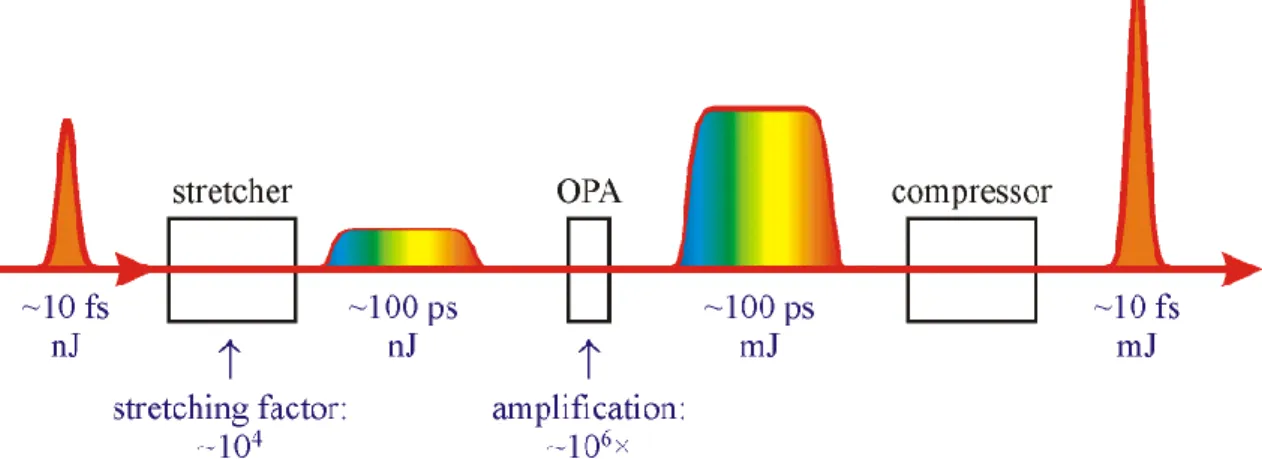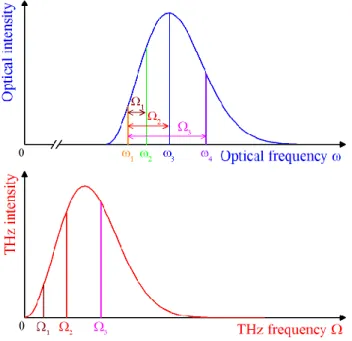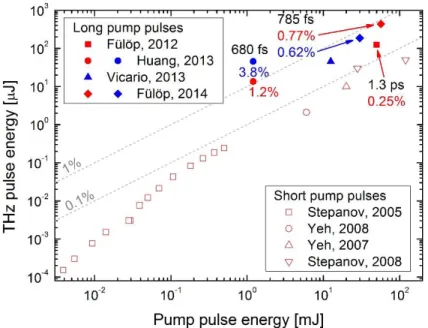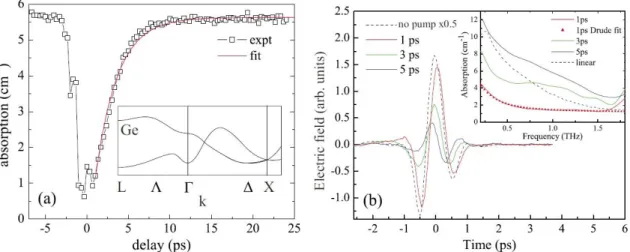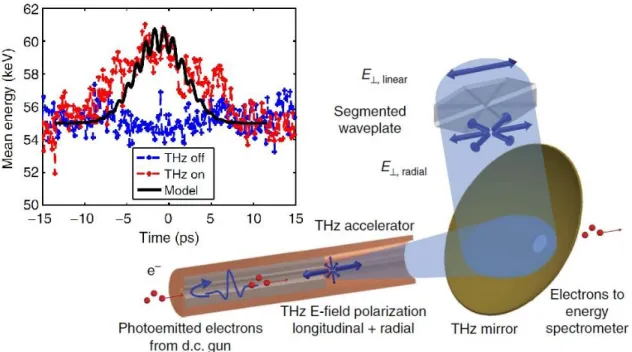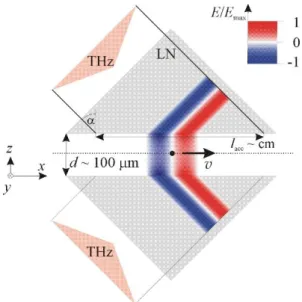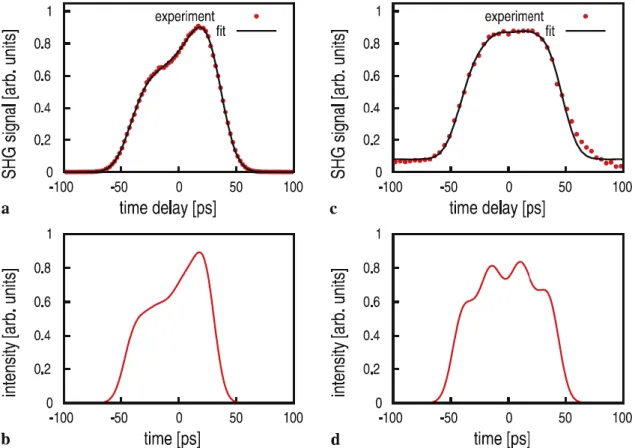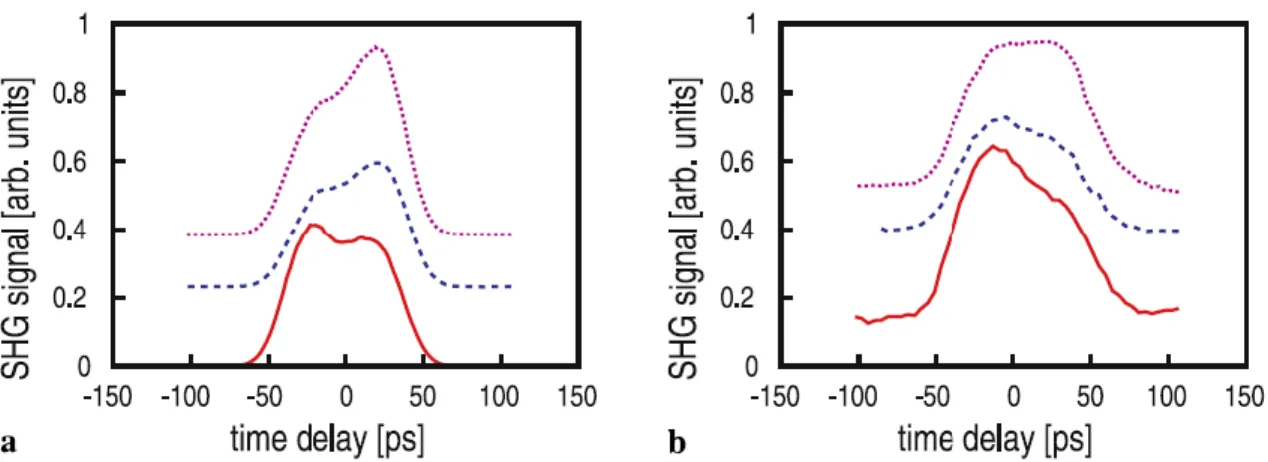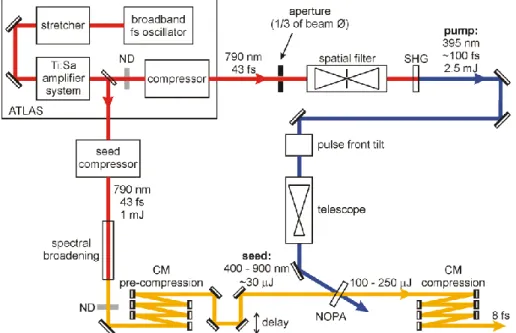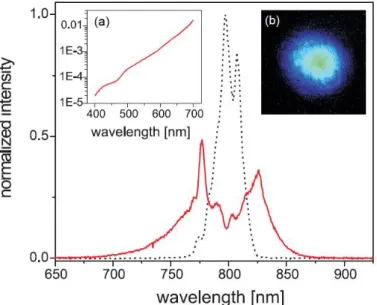High-Intensity Pulses in the Terahertz and Visible Ranges
DSc Dissertation
József András Fülöp
MTA-PTE High-Field Terahertz Research Group Pécs, 2017.
This work is dedicated to my wife Nurcahaya and to my children Sára, Sámuel, Nóra, and Magdaléna.
Contents
Contents ... 2
Abbreviations ... 3
I. Introduction ... 4
II. Scientific background ... 6
1. Nonlinear optical interactions ... 7
2. Optical parametric amplification ... 10
3. Generation and applications of THz pulses... 12
3.1. THz generation by optical rectification ... 13
3.2. Tilted-pulse-front pumping ... 15
3.3. Materials for optical rectification ... 16
3.4. Applications of THz pulses ... 21
III. Results ... 25
4. Optical pump sources for high-field applications ... 26
4.1. Shaping of picosecond pulses for pumping optical parametric amplification ... 26
4.2. Short-pulse optical parametric chirped-pulse amplification for the generation of high-power few-cycle pulses ... 30
5. LiNbO3 THz sources with extremely high energy ... 35
5.1. Basic design aspects ... 35
5.2. Pulse-front tilting setups for large pumped area ... 44
5.3. Efficient generation of high-energy THz pulses ... 49
5.4. Nonlinear distortion of intense THz beams ... 59
6. High average power THz sources ... 64
7. Novel semiconductor THz sources ... 69
7.1. Prospects of efficient semiconductor THz sources ... 69
7.2. A monolithic semiconductor THz source ... 75
7.3. Scaling potential ... 80
IV. Summary ... 86
8. Magyar nyelvű összefoglaló ... 89
Acknowledgements ... 92
References ... 93
Abbreviations
2D two-dimensional 2PA, 3PA, 4PA
two-, three-, four-photon absorption ARWG absorption-reduced waveguide CG contact grating
cLN congruent lithium niobate (LiNbO3) CPA chirped-pulse amplification
CT cryogenic temperature
DFG difference-frequency generation EOS electro-optic sampling
FCA free-carrier absorption FL Fourier limit, Fourier limited FWHM full width at half maximum GVD group velocity dispersion MPA multi-photon absoprtion
OPA optical parametric amplification
OPCPA optical parametric chirped-pulse amplification OR optical rectification
LN lithium niobate (LiNbO3) PFT pulse-front tilt
RT room temperature
SFG sum-frequency generation SHG second-harmonic generation
SPIDER spectral phase interferometry for direct electric field reconstruction sLN stoichiometric lithium niobate (LiNbO3)
TPFP tilted-pulse-front pumping
I. Introduction
The application possibilities of electromagnetic radiation sources are determined and limited by their coherence, spectral content (bandwidth), and intensity or field strength.
These features are often interrelated. New applications require the improvement of source characteristics and to tailor them to specific needs. The advent of the laser enabled the construction of light sources with unprecedented coherence properties. The high degree of coherence was essential for pushing the limits both in bandwidth and intensity.
The energy of highly coherent radiation can be confined to extremely narrow spectral or temporal intervals. An extremely narrow bandwidth and high frequency stability is needed for precision spectroscopy. The confinement of radiation energy to very short time intervals opened up the field of ultrafast spectroscopy. Generally, the achievable pulse duration is inversely proportional to the spectral bandwidth (a more precise formulation can be found e.g. in Ref. [1]). Thus, a very short pulse must have a very large bandwidth.
Besides time-resolved studies on ultrafast time scales, the confinement of light energy to very short time scales also enables to reach extremely high intensities and field strengths. Prominent application examples of ultrahigh-intensity pulses are laser-driven electron and ion acceleration.
The emission bandwidth and wavelength range of laser materials sets a limit on the achievable pulse duration. In laser amplifier systems the bandwidth can be significantly reduced by the gain-narrowing effect. Furthermore, spectroscopic applications often request wavelengths which are not, or not easily, accessible by laser materials. Thus, frequency conversion and spectral broadening of laser sources is of utmost practical importance.
The generation of new frequency components, not present at the input of an optical device, requires a nonlinear process. In 1961, only one year after the first demonstration of laser operation, second-harmonic generation of a laser beam was performed. This marked the birth of nonlinear optics. Second-harmonic generation and a wealth of other nonlinear optical processes represent key technologies to reach frequency ranges or bandwidths which are not directly accessible by laser materials. Nonlinear frequency conversion of laser radiation is now the basis for coherent radiation sources from the X-ray to the microwave regime. Besides accessing new spectral regimes, nonlinear optical processes, such as optical parametric amplification, can also be used to reach unprecedented peak intensities. Nonlinear optical frequency conversion or amplification were essential in making the laser an extremely versatile tool for science and technology.
This work deals with topics on the development of nonlinear optical amplification and frequency conversion techniques.
The ultimate limit for shortening the pulse duration is set by the carrier frequency of the radiation. The duration of a single oscillation cycle is about 3 fs for optical wavelengths near 1 μm. Frequency conversion of laser radiation to the extreme ultraviolet or soft x-ray enabled to significantly shorten the pulse duration because of the much
shorter oscillation cycle. The shortest electromagnetic pulses routinely available today from laser-driven secondary sources are about 50 attosecond long. Such pulses can be generated by high-order harmonic generation in gas jets, a highly nonlinear process requiring intense few-cycle driver laser pulses. The generation of stronger and shorter attosecond pulses may be possible at even shorter wavelengths generated from solid- density targets with the help of high-power few-cycle laser pulses.
One main goal of the work presented here was to develop the technology of high- power few-cycle pulse sources in the visible—near infrared spectral range using optical parametric amplification. This was motivated by the quest for suitable primary sources to drive novel attosecond sources and other high-field applications like laser-driven electron acceleration. The experimental work related to optical parametric amplification was mainly carried out at the Max Planck Institute of Quantum Optics and the Ludwig Maximilians University in Garching near Munich, Germany.
Nonlinear optical frequency conversion techniques are not only suitable for the generation of short-wavelength radiation but can also be utilized to reach the infrared and terahertz (THz) spectral ranges. For the latter, optical rectification is a suitable technique.
THz radiation can be used to access degrees of freedom in matter with low excitation energies. THz pulses with extremely high energy and field strength are enabling novel applications, such as the resonant control over ionic motion, bound and free electrons, as well as nonresonant and strong-field interactions. Intense THz pulses hold promise for the development of a new generation of compact particle and X-ray sources. Laser- and THz-driven particle accelerators with unprecedented flexibility can be important for free- electron lasers and materials science, and can revolutionize medical therapy with X-ray, electron, or proton beams.
Another main goal of the work presented here was to develop intense THz sources based on optical rectification, using optical pump pulses with tilted intensity front for phase matching. This research was motivated by enabling new applications in high-field THz science, such as THz-driven particle acceleration, or resonant and nonresonant control of matter. The work related to the generation and application of intense THz pulses was mainly carried out at the University of Pécs and the MTA-PTE High-Field Terahertz Research Group, in close collaboration with a number of other institutes and industrial partners.
The structure of the dissertation is as follows. Part II is devoted to a brief description of the scientific background. Part III presents the scientific achievements. Part IV is the summary of the work, formulated in thesis points. The acknowledgement and the list of references are given at the end. English language has been chosen in order to enable not only Hungarian but also foreign students and colleagues to use the dissertation as an introduction to the topic and to serves as a source for background information on this research.
II. Scientific background
The advent of ultrafast solid-state lasers pumped by efficient laser diodes lead to a technological breakthrough and had a transformative impact on many areas of science, which is hard to overestimate. Ultrashort light pulses down to few-cycle pulse durations can be generated by compact solid-state laser oscillators, which utilize Kerr lens mode locking, a technique based on a third-order nonlinear optical process. Nonlinear optical processes also provide essential tools both for the generation of high-power few-cycle pulses as well as to extend the spectral range accessible by laser sources. The very basics of nonlinear optics are summarized in Section 1.
Weak ultrashort pulses, delivered for example by a Ti:sapphire laser oscillator, can be amplified to TW–PW power levels by chirped-pulse amplification (CPA) without the risk of optical damage. However, it is challenging to achieve high peak power with laser amplification while simultaneously maintaining few-cycle pulse duration. An alternative route is offered by optical parametric amplification (OPA), a second-order nonlinear optical process. Combining OPA with CPA, a technology called optical parametric chirped-pulse amplification (OPCPA), enables to amplify few-cycle pulses to unprecedented peak powers. Some basic features of the OPA process are summarized in Section 2.
Various laser sources can emit radiation in the THz spectral range [2]. Examples are molecular gas lasers involving transitions between rotational levels, the p-type germanium laser, the quantum-cascade laser, or the free-electron laser. These lasers typically emit continuous-wave radiation or many-cycle pulses. Optical rectification (OR), another second-order nonlinear optical process, can be used to generate long- wavelength radiation in the infrared and THz spectral range. Single-cycle THz pulses can be generated by OR when pumped by femtosecond lasers pulses. The fundamentals of THz pulse generation by OR are summarized in Section 3. A few examples of novel application possibilities are also given.
1. Nonlinear optical interactions
A sufficiently strong optical field can modify the optical properties of a material system.
In such a case the response of a material system to the applied optical field depends in a nonlinear manner on the strength of the optical field [3]. Historically, the discovery of second-harmonic generation (SHG) by Franken et al. in 1961, shortly after the demonstration of the first working laser, marked the beginning of the field of nonlinear optics. Typically, only laser light is sufficiently intense to significantly modify the optical properties of materials.
The effect of an external electric field 𝐄 on the medium can be described by the time-dependent average density of the induced (atomic or molecular) electric dipole moments in the medium, 𝐏(𝐄). For small field strengths the dependence of the induced polarization in a medium on the electric field is linear:
𝐏(𝐄) = 𝜀0𝜒(1)𝐄 = 𝐏(1). (II.1) In general, the linear susceptibility 𝜒(1) is a second-rank tensor and it can be frequency dependent. 𝜀0 is the electric permittivity of free space. For higher field strengths, the material response to the applied field may become nonlinear, which can be described by a Taylor-series expansion:
𝐏(𝐄) = 𝜀0(𝜒(1)𝐄 + 𝜒(2)𝐄𝐄 + 𝜒(3)𝐄𝐄𝐄 + ⋯ )
= 𝐏(1)+ 𝐏(2)+ 𝐏(3)+ ⋯
= 𝐏(1)+ 𝐏NL.
(II.2)
Here 𝜒(𝑛) is the 𝑛th-order nonlinear susceptibility, a tensor of rank 𝑛 + 1.
During propagation of a light beam in a medium with nonlinear response new frequency components can be generated which were not contained in the input. Let us consider a nonlinear medium with second-order nonlinear susceptibility 𝜒(2) and an input field which contains two distinct frequency components:
𝐸(𝑡) =1
2𝐸̂1𝑒𝑖𝜔1𝑡+1
2𝐸̂2𝑒𝑖𝜔2𝑡+ c.c. (II.3) For the sake of simplicity, the vector notation has been dropped here and only the time dependence of the electric field is considered. The second-order nonlinear response is given as follows:
𝑃(2)(𝑡) = 𝜀0𝜒(2)𝐸𝐸
=1
4𝜀0𝜒(2)[𝐸̂12𝑒𝑖2𝜔1𝑡+ 𝐸̂22𝑒𝑖2𝜔2𝑡+ 2𝐸̂1𝐸̂2𝑒𝑖(𝜔1+𝜔2)𝑡 + 2𝐸̂1𝐸̂2∗𝑒𝑖(𝜔1−𝜔2)𝑡+ 2𝐸̂1𝐸̂1∗] + c.c.
(II.4)
The first two terms describe SHG of both frequency components. The further terms describe sum-frequency generation (SFG), difference-frequency generation (DFG), and OR, respectively. Here, the latter is a static (DC) field.
In the more general case, the field can be composed of several monochromatic components 𝜔𝑛 with slowly-varying amplitudes 𝐄̃𝑛(𝐫):
𝐄(𝐫, 𝑡) =1
2∑ 𝐄̃𝑛(𝐫)𝑒𝑖(𝜔𝑛𝑡−𝐤𝑛𝐫)
𝑛
+ c.c. (II.5)
The induced nonlinear polarization can be written as follows:
𝐏NL(𝐫, 𝑡) =1
2∑ 𝐏̃𝑛NL(𝐫)𝑒𝑖(𝜔𝑛𝑡−𝐤𝑛𝐫)+ c. c.
𝑛
(II.6)
For waves propagating in the 𝑧-direction with negligible diffraction one obtains the following coupled wave equations:
𝜕
𝜕𝑧𝐄̃𝑛(𝑧) = −𝑖 𝜔𝑛
2𝑐𝜀0𝑛𝑛𝐏̃𝑛NL(𝑧), (II.7) where 𝑛𝑛 = 𝑛(𝜔𝑛) is the refractive index. This is the simplest form of the coupled wave equations in nonlinear optics. It shows that 𝐄̃𝑛 will grow at a maximal rate if the polarization wave has a phase lead of π/2 with respect to the field (i.e. the arguments of 𝐏̃𝑛NL and 𝑖𝐄̃𝑛 are the same). If the sign of the phase difference is reversed (a phase lag of π/2), the field will decay at a maximal rate. If the polarization and field are in phase, the amplitude of the field will be unchanged, but its phase will change under propagation, meaning a modification of the refractive index.
In many practical situations, a measurable output field can be generated usually at just one or some of all possible new frequencies. The reason is that a fixed phase relationship (phase matching, see below) should be maintained during the propagation, which cannot be fulfilled simultaneously for all possible frequency combinations.
Therefore, in the simplest situation when dealing with second-order nonlinear processes, it is sufficient to consider the interaction of three waves coupled by the nonlinear polarization (three-wave mixing). For their frequencies 𝜔1 ≤ 𝜔2 ≤ 𝜔3 energy conservation requires
𝜔3 = 𝜔1+ 𝜔2. (II.8)
Of particular interest for this work are OPA and OR, specific cases of three-wave mixing, which differ in initial conditions. OR is a special case with 𝜔3 ≈ 𝜔2 and 𝜔1 ≪ 𝜔2, 𝜔3. The coupled wave equations take the following form for three-wave mixing:
𝜕
𝜕𝑧𝐄̃1(𝑧) = −𝑖 𝜔1
2𝑐𝑛1𝜒(2)𝐄̃3(𝑧)𝐄̃2∗(𝑧)𝑒−𝑖Δ𝑘𝑧,
𝜕
𝜕𝑧𝐄̃2(𝑧) = −𝑖 𝜔2
2𝑐𝑛2𝜒(2)𝐄̃3(𝑧)𝐄̃1∗(𝑧)𝑒−𝑖Δ𝑘𝑧,
𝜕
𝜕𝑧𝐄̃3(𝑧) = −𝑖 𝜔3
2𝑐𝑛3𝜒(2)𝐄̃1(𝑧)𝐄̃2(𝑧)𝑒𝑖Δ𝑘𝑧.
(II.9)
The phase mismatch parameter is defined as Δ𝑘 = 𝑘3− 𝑘2 − 𝑘1.
It is instructive to introduce the modified field variables 𝐴̃𝑖= √𝑛𝑖⁄𝜔𝑖𝐸̃𝑖 (𝑖 = 1, 2, 3), where the vector notation has been dropped for simplicity. With these, the coupled wave equations take the following simpler form:
𝜕𝐴̃1
𝜕𝑧 = −𝑖 𝜂𝐴̃3𝐴̃2∗𝑒−𝑖Δ𝑘𝑧,
𝜕𝐴̃2
𝜕𝑧 = −𝑖 𝜂𝐴̃3𝐴̃1∗𝑒−𝑖Δ𝑘𝑧,
𝜕𝐴̃3
𝜕𝑧 = −𝑖 𝜂𝐴̃1𝐴̃2𝑒𝑖Δ𝑘𝑧.
(II.10)
The advantage is that the same coupling coefficient 𝜂 = (𝜒(2)⁄ )√𝜔2𝑐 3𝜔2𝜔1⁄(𝑛3𝑛2𝑛1) can be used in all three equations. |𝐴̃𝑖|2 is proportional to the photon current density:
Φ𝑖 = 𝐼𝑖⁄ℏ𝜔𝑖= (𝑐𝜀0⁄ )|𝐴̃2ℏ 𝑖|2 (𝑖 = 1,2,3).
2. Optical parametric amplification
Few-cycle laser pulses with unprecedented peak powers are crucial for the investigation of laser-driven strong-field phenomena [4], having become an accessible field of research with the advent of suitable laser systems. Conventional laser-amplification technology can provide very high power levels, but the pulse duration determined by the laser material is limited to the tens-of-femtosecond range. The technique of OPA, which allows for very large amplification bandwidths, has opened up a new path towards generating few-cycle pulses with unprecedented peak powers [5-13].
In OPA amplification takes place in a nonlinear optical crystal. OPA can be viewed as DFG with special initial conditions, where a weak input beam (the seed) with the frequency 𝜔1 or 𝜔2 is being amplified with the help of a strong pump beam of frequency 𝜔3, which is being depleted. The pump beam has the highest frequency: 𝜔1 ≤ 𝜔2 < 𝜔3. The field with the medium frequency is usually called the signal and that with the smallest frequency the idler. At degeneracy, these two frequencies are equal.
Typically, the idler field is not present in the input, but it is generated during OPA. Both signal and idler are amplified in the OPA process. In the simplest cases, Equations (II.9) or (II.10) can be used to describe the OPA process. The description of broadband amplification with short pulses requires more sophisticated models, taking into account the different group velocities of the interacting pulses [14], material dispersion, and possibly third-order cross- and self-phase modulation effects [15].
In OPA, phase-matching in a non-collinear geometry (Figure 1) allows for extremely large amplification bandwidths [5], which can be significantly larger than that of any known laser medium. This enables the amplification of broadband seed pulses using relatively narrowband pump pulses delivered by conventional laser amplification technology. The gain can be very high even in a short length of material, which results in a lower B-integral (the accumulation of nonlinear phase by passing through material).
Furthermore, in contrast to laser amplifiers, essentially no energy is converted into heat, thereby eliminating thermal distortions of the beam.
Figure 1. (a) Scheme of noncollinear OPA. (b) Phase matching in a noncollinear OPA.
In order to reach the highest possible peak intensities, in high-power systems OPA is usually combined with CPA, called optical parametric chirped-pulse amplification (OPCPA, Figure 2), a scheme first proposed by Dubietis et al. [16]. In such a system, pulse energies as high as 35 J were achieved in 84-fs pulses [17]. In the few-cycle regime 10-fs pulses with 90 mJ energy were demonstrated from an OPCPA system [18]. In
Nd:YAG laser are usually on the order of 100 ps [11, 12, 18]. Some smaller-scale systems use shorter pump pulses of ~100 fs duration and were able to generate sub-10-fs pulse durations, however, only with energies in the µJ range [8-10, 19-21]. 300 µJ output pulse energy has been reported from an OPCPA system [22] pumped by 150-fs pulses, however, the signal pulse duration was about 20 fs. Novel concepts and perspectives to reach high average and peak powers simultaneously are summarized in the review article Ref. [23].
Figure 2. Scheme of a typical OPCPA system for generating few-cycle pulses.
3. Generation and applications of THz pulses
The widespread availability of table-top laser sources triggered the development of various types of laser-driven pulsed THz sources. This development now enables to routinely provide THz pulses with unprecedented energies as well as peak electric and magnetic field strengths throughout the entire THz spectral range [24]. Different laser- based THz generation techniques can be used to access different parts of the THz spectral range extending from 0.1 THz to 10 THz (1 THz = 1012 Hz). Some of the recently developed technologies enable to generate radiation with even larger bandwidth or tuning range up to 100 THz and beyond, which lead to an extension of what is called the THz spectral range. An overview of the approximate spectral coverage and the achieved highest pulse energies of various technologies is given in Figure 3.
Figure 3. Some of the highest reported experimental values of THz pulse energy and approximate spectral coverage for various types of pulsed THz sources. The short vertical lines indicate the approximate frequencies of the spectral peaks. LN: LiNbO3.
Sources driven by femtosecond laser pulses are capable of delivering single-cycle or nearly-single-cycle THz pulses with energies on the µJ–mJ level and MV/cm peak electric field strengths. In the low-frequency part of the THz range (about 0.1–2 THz), it is mainly OR in lithium niobate (LiNbO3, LN) and in different semiconductors which can be used to provide intense pulses. At medium frequencies (about 1–20 THz), organic crystal have been proven to be very efficient. Multi-cycle pulses at higher frequencies (10–70 THz) can be generated by DFG in GaSe. Extremely large bandwidths covering the entire range of 1 to 100 THz or even beyond could be achieved with two-color laser- plasma sources.
As a result of the development in source technology, intense THz pulses have proven significant discovery and application potential. This relies on their interaction with various degrees of freedom in matter [25, 26], including (i) nuclear dynamics with ions (acceleration [27]), molecules (vibration and rotation [28]), and condensed matter (lattice vibrations [29]); (ii) spin [30]; and (iii) electrons (excitations of electron-hole pairs [31], Cooper pairs, electron acceleration [32]). Some of the new applications are highlighted
3.1. THz generation by optical rectification
The generation of THz radiation, called far-infrared at that time, in electro-optical materials was investigated as early as 1971 [33, 34]. Generation of nearly single-cycle THz pulses by OR was first demonstrated by Auston et al. in 1984 [35].
OR, a second-order nonlinear optical process, is a special case of DFG [3]. A femtosecond optical pulse can be used to drive OR. Spectral components with angular frequencies 𝜔 and 𝜔 + Ω from the optical pulse can combine by DFG to generate a new spectral component with the angular frequency Ω (Figure 4). Thus, OR can be described as intra-pulse DFG, as opposed to inter-pulse DFG with two input pulses (which may have different carrier frequencies). The nonlinear polarization induced by the pump pulse can be calculated as [36]
𝑃NL(Ω) = 𝜀0𝜒(2)∫ 𝐸(ω + Ω)𝐸∗(𝜔)𝑑𝜔
∞
0
, (II.11)
where 𝜀0 is the permittivity of free space, 𝜒(2) is the second-order nonlinear susceptibility of the medium, 𝐸(𝜔) is the one-sided (𝜔 > 0) Fourier-component of the pump pulse, 𝜔 is the optical frequency, and Ω is the difference frequency. Typical optical pump pulse durations used for OR range from about 30 fs to 1.5 ps. Accordingly, the generated difference frequency spectral components are in the THz range. According to Equation (II.11), a narrowband pump pulse generates low THz frequencies, while a broadband pulse can generate a broad THz spectrum containing also higher THz frequencies.
Figure 4. Schematic representation of optical and THz spectra in case of OR. Pairs of optical frequency components (upper panel, note the horizontal axis break) generate a THz spectral components at their difference frequencies (lower panel).
The build-up of the THz field over macroscopic distances in the medium can be described by the coupled wave equations (II.9) or (II.10) [3]. In many cases, when the generated THz field is weak, the optical-frequency fields can be regarded as constant and
only the equation for the THz field needs to be retained. Besides the nonlinear polarization, OR is also influenced by the dispersion of the medium. The efficiency of OR is highest when the phase matching condition, Δk = 0, is fulfilled [3, 36, 37], where
Δk = k(Ω) + k(𝜔) − k(𝜔 + Ω) ≈ k(Ω) − 𝜕k
𝜕𝜔|
𝜔0∙ Ω. (II.12) The second, approximate equation holds if Ω ≪ 𝜔, which is usually valid for THz generation by OR. In case of collinear phase matching, Equation (II.12) gives Δ𝑘 =
|Δk| = [𝑛(Ω) − 𝑛g(𝜔0)] ∙ Ω 𝑐⁄ . Here, 𝜔0 is the pump central (carrier) frequency, 𝑐 is the speed of light in vacuum, 𝑛 and 𝑛g are the refractive and group indices, respectively.
Thus, in case of phase matching, the phase velocity of the generated THz radiation, 𝑣 = 𝑐 𝑛⁄ , equals the group velocity of the optical pump pulse, 𝑣g = 𝑐 𝑛⁄ g, and the following velocity matching condition holds:
𝑣(Ω) = 𝑣g(𝜔0). (II.13) Materials suitable for OR are semiconductors such as CdTe, GaAs, GaP, GaSe, or ZnTe, ferroelectric materials such as LN or lithium tantalate (LiTaO3), and organic materials such as DAST, OH1, DSTMS, or HMQ-TMS. Their properties are briefly described in Section 3.3, more details can be found in the literature [24, 38-42]. For the selection of a suitable material it is instructive to consider the expression for the THz generation efficiency in case of phase matching [37]:
𝜂(Ω) = 2Ω2𝑑eff2 𝐿2𝐼
𝜀0𝑐3𝑛2(𝜔0)𝑛(Ω)∙ 𝑒−12𝛼(Ω)𝐿∙sinh2[14𝛼(Ω)𝐿]
[14𝛼(Ω)𝐿]2
. (II.14)
Here, 𝐿 is the material length and 𝐼 is the pump intensity. Obviously, a large effective nonlinear coefficient, 𝑑eff, and a small THz absorption coefficient, 𝛼(Ω), is advantageous for a high efficiency. The scaling of the efficiency with the square of the THz frequency enables significantly higher efficiencies at higher THz frequencies and makes it challenging to achieve comparable values at low THz frequencies. An important property of OR is that a carrier-envelope phase stable pulse is generated when driven by an optical pulse. Carrier-envelope phase stability is essential in many field-driven applications (see Section 3.4).
It is worth to mention that Wynne and Carey gave an integrated description of THz generation driven by a laser pulse travelling through the medium and inducing a polarization oscillating at THz frequencies [43]. This description is valid for various mechanisms, such as OR, microscopic currents from photoinduced charge transfer in aligned molecules, and current surge (photoconductive antennas). In the simplest case of an instantaneously responding medium, no dispersion in the THz range, and perfect phase matching, the electric field of the THz pulse is shaped as the time derivative of the optical pulse envelope. For Gaussian-like pump pulse envelopes this means that single-cycle THz pulses can be generated.
In a realistic model of intense THz sources, besides OR, usually other effects have
range, determined by the complex dielectric function of the material. Absorption of pump light, especially multi-photon absorption, can cause an increased carrier concentration and absorption in the THz range [41, 44]. In case of very strong THz fields, it is important to take into account the influence of the generated THz pulse on the optical pump pulse caused by their nonlinear interaction (sum- and difference-frequency generation between optical and THz fields) [45-47]. At high pump intensities, other nonlinear effects may also occur, such as self-phase modulation, second- and third-harmonic generation, or stimulated Raman scattering. In noncollinear geometries (see Section 3.2), spatio- temporal coupling can lead to additional complexity.
3.2. Tilted-pulse-front pumping
The phase-matching condition, given by Equation (II.13), can be fulfilled in some cases by utilizing the birefringence of the nonlinear material. One example is GaSe. Other semiconductors, such as ZnTe, GaP, or GaAs, are optically isotropic. Here, collinear phase matching is possible only in specific cases, at certain pump and THz frequencies.
One example is ZnTe pumped at 0.8 μm wavelength to generate radiation around 1 THz frequency. At other wavelengths or in other materials a specific noncollinear geometry, called tilted-pulse-front pumping (TPFP), may be used for phase matching.
The TPFP technique was proposed by Hebling et al. to enable efficient THz pulse generation in LN [48], a material with high effective nonlinear coefficient but lack of collinear phase matching possibility for OR. Recently, it has also been applied to semiconductors [44, 49-51]. TPFP is of great practical importance, as it is scalable to high THz pulse energies simply by increasing the pumped area. It enables broadband (achromatic) phase matching for OR in a noncollinear geometry involving pump angular dispersion using pump pulses with tilted intensity front [24, 48, 52].
The scheme of TPFP is shown in Figure 5a. The pump pulse propagates with a tilted intensity front inside the nonlinear medium. The tilt angle of the pulse front with respect to the phase fronts is 𝛾. The THz radiation is generated by the induced polarization along the tilted pulse front. Therefore, according to Huygens’ principle, the THz radiation propagates perpendicularly to the pump pulse front. A strong THz field can build up if the source (the induced polarization along the pump pulse front), moving with the group velocity 𝑣g(𝜔0), remains in phase with the THz field propagating with the phase velocity 𝑣(Ω). According to Figure 5a, this is fulfilled at the pulse-front tilt (PFT) angle 𝛾 satisfying the following velocity matching condition:
𝑣(Ω) = 𝑣g(𝜔0) ∙ cos 𝛾. (II.15) This equation is a more general form of Equation (II.13). It states that the projected pump group velocity needs to match the THz phase velocity. As the pump pulse propagates, it slides along the THz phase front. Obviously, Equation (II.15) can be fulfilled only in materials with a THz phase velocity smaller than, or equal to the pump group velocity.
Figure 5. (a) Scheme of TPFP with pump pulse front (thick red solid line) and THz phase front (thick gray dashed line) [24]. (b) Noncollinear phase matching in TPFP.
The TPFP scheme can also be described with wave vectors as noncollinear vector phase matching (Figure 5b). The PFT is linked to angular dispersion according to the relation [48, 52, 53]:
tan 𝛾 = − 𝑛 𝑛g𝜆𝑑𝜀
𝑑𝜆. (II.16)
The propagation angles, 𝜀(ω), with respect to the beam propagation direction, 𝑧, are typically small and for the 𝑧-projection of the wave vectors in case of phase matching 𝑘(Ω) cos 𝛾 ≈ 𝑘(𝜔0+ Ω) − 𝑘(𝜔0) ≈ Ω(𝑑𝑘 𝑑𝜔⁄ )|𝜔0 is a good approximation. By using the definitions of the wave vector, phase, and group velocities, one can easily obtain from this relation the velocity-matching condition of Equation (II.15).
The angular dispersion present in TPFP schemes contributes to the group velocity dispersion (GVD) [52], in addition to the contribution from material dispersion. The GVD parameter can be written as follows [53, 54]:
𝐷 =𝑑(𝑣g−1) 𝑑𝜆 =𝜆
𝑐[𝑛 (𝑑𝜀 𝑑𝜆)
2
−𝑑2𝑛
𝑑𝜆2], (II.17)
where the first and second terms originate from angular dispersion and material dispersion, respectively. For a large pulse front tilt angle the former can dominate over the latter, thereby significantly enhancing the variation of the pump pulse duration with propagation distance [1]. The influence of GVD, originating from angular dispersion, on THz generation will be discussed for LN in Section 5.1 and for semiconductors in Section 7.1.
3.3. Materials for optical rectification
Materials suitable for OR are ferroelectric materials such as LN or LiTaO3, semiconductors such as CdTe, GaAs, GaP, GaSe, or ZnTe, and organic materials such as DAST, OH1, DSTMS, or HMQ-TMS. Detailed comparison of their properties can be found in the literature [24, 38-42]. Below, a brief description of the properties, most important for OR, of these materials is given.
Lithium niobate
LN is one of the most widely used materials for intense THz sources. Its properties relevant for THz generation by OR are discussed in Refs. [24, 38-41, 55, 56]. The most important features are summarized below:
LN has a high effective nonlinear coefficient of 𝑑eff= 𝑑33 = 168 pm/V. This is higher than typical values for semiconductors, which range from about 25 pm/V to 80 pm/V, but smaller than that of organic materials. In order to utilize 𝑑33 for OR, both the pump and the THz should be polarized along the dielectric 𝑍 axis of LN.
The THz absorption coefficient is relatively high (about 16 cm–1 at 1 THz) at room temperature, but can be significantly reduced (below 5 cm–1) by cooling the crystal to cryogenic temperatures [55]. Phonon absorption limits the useful THz spectral range to the low-frequency part of the THz spectrum (up to about 4.5 THz [39]).
Even though LN is optically anisotropic, utilizing birefringence for phase matching by angle tuning in OR is not possible below the transverse optical phonon frequency, due to the strong contribution of the lattice vibration to the dielectric function [39].
Owing to the very different optical group and THz phase velocities, a large PFT angle of about 63° is required for phase matching (see Section 3.2).
It is available in congruent (cLN) and stoichiometric (sLN) forms, where somewhat higher THz generation efficiencies were achieved with the latter. Both types are available in large sizes up to several cm. To prevent photorefractive damage, the strong photorefractive effect can be significantly reduced by doping with MgO. The optimal doping concentration was found to be about 0.7% for sLN and 6% for cLN [57].
LN can be pumped at high intensities (~100 GW/cm2) owing to its high damage threshold. Multiphoton absorption (MPA) of the pump usually plays a minor role as the material is insulator with a large bandgap of 3.8 eV. At the typical pump wavelengths of 0.8 µm and 1.03 µm, the lowest order effective MPA is three-photon absorption (3PA) and four-photon absorption (4PA), respectively.
THz generation from LN was demonstrated as early as 1971 [34], however the efficiency was extremely low due to lack of phase matching. It was the introduction of the TPFP technique [48], which enabled more efficient THz pulse generation from this material (empty symbols in Figure 6, see also Figure 3) and the increase of the THz pulse energy by several orders of magnitude [58, 59]. The potential of the technique for high- energy THz pulse generation was demonstrated in subsequent experiments, where 10 μJ [60], 30 μJ [61], and 50 μJ [62] pulse energies were reported with efficiencies of about 0.1% or below. Peak electric field strengths up to 2.1 MV/cm were reported [63, 64]. In these experiments, short pump pulses of about 100 fs were used.
Figure 6. Measured scaling of the THz pulse energy with the pump pulse energy in LN using TPFP for short (about 100 fs) and long (0.5 ps–1.5 ps) pump pulses. Red (blue) symbols: room (cryogenic) crystal temperature. The dashed grey lines indicate the 0.1% and the 1% levels of pump-to-THz energy conversion efficiency.
Semiconductors
Semiconductors are among the most frequently used materials in generation and detection of THz radiation. As THz sources they can constitute the nonlinear optical material for OR, DFG, or OPA. They also form the photoconductive substrate for biased antenna structures (photoconductive antennas). As detectors, semiconductors are applied in electric-field waveform measurement of broadband THz pulses using (unbiased) photoconductive antennas or electro-optic sampling.
Photoconductive antennas are frequently used for low-energy THz sources, especially in linear THz time-domain spectroscopy systems. Large-area photoconductive antennas should be mentioned as alternative sources of intense THz pulses [65-67]. The highest energy demonstrated with this technique was 3.6 µJ using a ZnSe interdigitated large aperture photoconductive antenna [67], corresponding to 143 kV/cm peak electric field with a spectral coverage between 0.05 THz and 1 THz. Limited THz pulse shaping, ranging from a symmetric single-cycle THz pulse to an asymmetric half-cycle THz pulse, was also possible by using a binary phase mask. However, scaling this technology to substantially higher energies and field strengths remained challenging.
THz pulse energies on the order of 1 µJ were demonstrated both with OR [49, 68]
and OPA [69]. Multicycle THz pulses at multi-10-THz frequencies were generated with energies up to 19 µJ by DFG [70]. Recent development indicates that OR will expectedly be scalable to substantially higher, mJ-level energies [50, 51, 71]. This is discussed in more detail in Section 7.
Important properties of semiconductors relevant for THz generation by OR are compiled in Refs. [24, 38-41, 56]. In brief, the main features are:
Semiconductors possess nonlinear coefficients smaller than that of LN and organic crystals, typically falling into the range of 25 pm to 80 pm/V.
The absorption coefficient of some semiconductors in the THz range is smaller than that of LN or organic crystals. This can partially compensate for their smaller nonlinearity. Semiconductors with higher phonon frequency can enable the generation of higher THz frequencies, such as GaP up to about 7 THz [39, 72].
Many semiconductors (for example CdTe, GaAs, GaP, ZnTe) are optically isotropic.
In some cases, collinear phase matching for OR is fulfilled at a specific pump wavelength. Examples are ZnTe pumped around 0.8 μm, GaP pumped around 1 μm, or GaAs pumped around 1.5 μm, where commercially available Ti:sapphire, Yb- doped, or Er-doped pump lasers can be used. At longer pump wavelengths TPFP has to be used for phase matching because the optical group index decreases with increasing wavelength. Birefringent phase matching was utilized in GaSe above the phonon frequency [69, 70].
At common pump wavelengths used for collinear phase matching, semiconductors exhibit two-photon absorption (2PA). The resulting increased free-carrier absorption (FCA) leads to a strong limitation of the maximum useful pump intensity and of the achievable THz generation efficiency. Longer pump wavelengths with only higher- order effective MPA can provide a solution. The issue of MPA is discussed in more detail in Section 7.
Organic crystals
Recently, organic crystals have gained increasing attention for the generation of intense THz pulses. Organic THz emitters (DAST [73-77], DSTMS [77-79], OH1 [77, 80], HMQ-TMS [42], etc.) can provide high laser-to-THz conversion efficiencies at room temperature and octave-spanning, or even multi-octave THz spectra. They have the largest nonlinear coefficients among materials used for OR. In case of DAST (Figure 7), for example, it is 𝑑eff= 615 pm/V [40, 81]. Organic crystals are best suited for accessing the mid-frequency (1 THz–20 THz) part of the THz range [75, 82].
Figure 7. Chemical structure of the organic salt 4-N, N-dimethylamino-4’-N’-methyl-stilbazolium tosylate (DAST). From Ref. [83].
For phase matching they typically require infrared pump wavelengths in the 1.2 µm to 1.6 µm spectral range (Figure 8), where a collinear geometry can be used for THz generation. Phase matching at the 0.8 μm wavelength of Ti:sapphire lasers is usually possible only at low frequencies below 1 THz. Organic crystals typically have several phonon absorption bands in the mid-frequency THz spectral range. Owing to the associated anomalous dispersion of the THz refractive index this can enable simultaneous
phase matching in different THz spectral bands, which are separated by absorption bands.
The complicated phase matching behaviour is illustrated in Figure 8a, showing the coherence length for OR in HMQ-TMS [82]. In consequence, the spectral intensity (Figure 8b) and phase structure of the generated THz pulses becomes complex, often leading to multi-cycle waveforms. Varying the pump wavelength was utilized for controlling the spectral coverage of the generated THz pulses (Figure 8b) [82].
Figure 8. (a) Coherence length 𝐿c= 𝜋 Δ𝑘⁄ for HMQ-TMS as function of optical pump wavelength and THz frequency. (b) Experimentally recorded THz spectra for various pump wavelengths. From Ref. [82].
Owing to the collinear phase matching geometry, the generated THz radiation is naturally collimated, enabling a good focusability of the beam for achieving high field strengths. High-power single-cycle THz pulses at a central frequency of 2.1 THz with 1 MV/cm electric and 0.3 T magnetic field strengths in focus were demonstrated by OR in DAST pumped with 1-mJ signal pulses of an infrared OPA [76]. The pump-to-THz conversion efficiency was as high as 2%.
White-light seeded OPAs are unfavourable for pumping THz generation in organic crystals because of their low optical-to-optical conversion efficiency, the often irregular beam profile containing hot spots, and the large shot-to-shot energy fluctuation.
These features limit the maximum usable pump fluence and can result in unstable THz emission [77, 79]. Cr:forsterite lasers, operating around 1.25 μm wavelength, enable efficient direct pumping of organic crystals. Larger than 10 MV/cm electric and 3 T magnetic field strengths were achieved with up to 3% efficiency by using such a laser to pump different organic crystals [77].
Possible limitations of the crystal size can be overcome by using partitioned crystals [74, 79]. High-field THz transients were reported with as high as 0.9 mJ energy, produced in a 400-mm2 partitioned DSTMS crystal by OR of 30-mJ laser pulses, delivered by a Cr:forsterite laser [78]. The frequency range covered was between 0.1 THz and 5 THz. The peak THz electric and magnetic field was 42 MV/cm and 14 T, respectively. The conversion efficiency was as high as 3%.
3.4. Applications of THz pulses
The great majority of previous investigations conducted with weak THz sources was restricted to a passive probing of matter using, for example, linear THz spectroscopy. The recent development of intense THz sources enabled to reach unprecedented electric and magnetic field strengths throughout the THz spectrum. Intense THz pulses with peak electric field strength on the 0.1 MV/cm to 1 MV/cm scale enabled a more active role: It became possible to initiate changes in matter and to trace the induced dynamics with THz pump—THz probe [84] or THz pump—optical probe spectroscopy. Resonant and non- resonant control of ionic, electronic, and spin degrees of freedom in a great variety of materials and structures could be demonstrated [30, 85]. Recent reviews on nonlinear light-matter interaction at THz frequencies can be found for example in Refs. [25, 26].
Nonlinear electronic response induced by THz pulses has been studied in Rydberg atoms [66], where the motion of an electronic charge across a distance of the order of 1 nm (the approximate radius of a Rydberg atom) results in extremely large transition dipole moments. The nonlinear THz response and ultrafast carrier dynamics in semiconductors was extensively studied [31, 84-87]. Coherent THz emission was observed in n-type GaAs excited by intense THz pulses [85]. The emitted THz field was due to stimulated emission from impurities having a populated excited state and an unpopulated ground state (inversion). Carrier heating and impact ionization dynamics in the low-band-gap semiconductor InSb was observed by THz pump—THz probe spectroscopy [84]. The strong saturation of FCA in n-type semiconductors and nonequilibrium carrier distribution were revealed and investigated by using the same technique [87] (Figure 9). High-field single-cycle THz pulses were used for bidirectional ultrafast electric-field gating of interlayer charge transport in a cuprate superconductor [88]. In the studies mentioned above, THz pulses with peak electric field strengths up to about 150 kV/cm were used. Highly nonlinear THz light-matter interaction in single- walled carbon nanotubes was investigated by THz pump—optical probe spectroscopy [89]. The high peak electric field of 0.7 MV/cm and the low effective mass of carriers resulted in ponderomotive energies exceeding the bandgap and in interband excitation, although the THz photon energy (4 meV) was much smaller than the bandgap (1 eV).
Lattice-based THz-induced nonlinear response was investigated in ferroelectric crystals [90, 91]. Ferroelectric materials can be switched between two different domain orientations, indicating the significant anharmonicity associated with the double-well lattice potential and the barrier between the wells. Because of lattice anharmonicity the nonlinear coefficient can be much larger in the THz domain than in the optical range. For example, about three orders of magnitude larger nonlinear refractive index (𝑛2) was estimated for LN in the THz range than in the visible [90, 92]. Intense THz pulses were used to impulsively drive the ferroelectric soft mode in a SrTiO3 thin film to a large amplitude and enabled the exploration of intrinsic quartic anharmonicity [93] (Figure 10).
As the THz electric field increased, the soft-mode absorption peak exhibited blueshifting and spectral narrowing. A classical anharmonic oscillator model suggested that the induced displacement is comparable to that of the ferroelectric phase transition. This indicates that THz coherent control over macroscopic order can also become possible.
Figure 9. THz pump—THz probe spectroscopy of Ge. (a) Spectrally averaged probe-pulse absorption as function of the THz probe delay for Ge. The inset shows the schematic illustration of the conduction-band structure. (b) The incident (black dotted line) and transmitted THz probe-pulse waveforms for Ge for 1 ps, 3 ps, and 5 ps probe delays, respectively. The inset shows the corresponding absorption spectra, the linear absorption spectrum (black dotted line), and a fit to the sum of two Drude-type components at 1 ps (red triangles). From Ref. [87].
Figure 10. Investigation of lattice anharmonicity in SrTiO3. (a) Schematic representation of the perovskite crystal structure and the soft-mode oscillation in SrTiO3 (X = Sr). (b) Potential 𝑉(𝑄) of the soft mode as a function of the Ti4+ ion displacement 𝑄. (c) Transmitted THz waveforms after traversing a SrTiO3 thin film for low (blue) and high (red) incident field amplitudes. (d) Resulting sample transmittances for weak and strong THz excitations. The stiffening of the soft mode with increasing vibrational amplitude is indicated by the shift of the resonance to a higher frequency. From Refs. [25, 93].
Efficient manipulation of charged particles and their (relativistic) beams requires THz field strengths on the order of 1 MV/cm to 10 MV/cm, or even up to the 100 MV/cm level. Today’s cutting-edge THz sources can provide such field strengths. The enhancement of attosecond-pulse generation by manipulating laser-ionized electron trajectories in high-harmonic generation in gases has been proposed [94-97]. Electron acceleration, undulation, deflection, and spatial as well as temporal focusing with THz fields is becoming possible [98] and will expectedly lead to important practical applications.
Using THz radiation in such applications can be superior to microwave radiation since THz pulses can be generated with significantly smaller temporal jitter to the electron bunch to be manipulated as compared to microwave pulses. Furthermore, the achievable
threshold surface electric field (𝐸s) scales with frequency 𝜈 and pulse duration 𝜏 as 𝐸s ∝
√𝜈 √𝜏⁄4 (see Ref. [32] and references therein). Clearly, higher frequencies and shorter pulses are beneficial for a higher accelerating gradient.
GeV/m accelerating gradients can be achieved by wakefield acceleration in laser plasma driven by TW–PW scale lasers. However, this technique is susceptible to instabilities. Direct acceleration by intense optical fields is also possible. However, due to the short optical wavelength, it is challenging to achieve a sufficiently precise synchronization of the electron bunch to the laser field and the bunch charge is also limited. Contrary to optical pulses, the much longer wavelength of THz pulses fits well to typical sizes of electron bunches.
THz-driven electron acceleration has been recently demonstrated in a proof-of- principle experiment [32], where 7 keV energy gain in 3 mm was shown in a dielectric- loaded cylindrical metallic waveguide (Figure 11). With more energetic THz pulses, GeV/m accelerating gradient and electron energies on the 10 MeV scale are predicted.
Figure 11. THz-driven linear accelerator. The inset shows the temporal profile of the mean electron energy with (red) and without (blue) THz field. From Ref. [32].
Many applications in materials science require ultrafast electron bunches at tens- or hundreds-of-keV energies. Ultrafast electron microscopy and diffraction can provide atomic-scale (pm) spatial and femtosecond temporal resolution [99]. Few-fs temporal resolution can be achieved with single-electron wavepackets. The generation of ultrafast electron bunches with high charge density requires very large electric field strengths to reduce the space-charge effects in the initial acceleration stage. THz-field driven electron sources can be superior to conventional electron guns in providing higher electron energies from very compact setups up to the (multi-)MeV range, in combination with significantly larger bunch charges, while preserving the short pulse duration. Recently, a THz-driven electron gun was demonstrated with promising scaling potential [100, 101].
Postacceleration of laser-generated proton beams has also been proposed [27]. It utilizes the evanescent field of THz pulses in the vacuum gap between a pair of dielectric
crystals (Figure 12). Laser-driven accelerators produce ion beams with only tens of MeV/nucleon energy at maximum within an extremely broad energy spectrum. It is predicted that the energy of a laser-generated proton bunch can be increased from 40 MeV to 56 MeV in five subsequent THz-driven postaccelerator stages and its initially broad energy distribution can be significantly narrowed down. This holds promise of compact and flexible ion accelerators suitable even for hadron therapy. Medical applications ideally require ion beams with ∼100 MeV/nucleon energy and relative energy fluctuation on the order of 1%. For this application, THz pulses in the 0.1 THz to 0.5 THz frequency range and peak electric field on the MV/cm level are particularly suitable. THz pulses with similar parameters were already demonstrated from a LN source [102]. A THz- driven ion source from a near critical density hydrogen plasma has also been proposed recently [103].
Figure 12. Scheme of the evanescent-wave postaccelerator for laser-generated proton beams. From Ref.
[27].
III. Results
In this Chapter, the achieved scientific results are presented.
Section 4 deals with the development of high-power few-cycle pulse sources in the visible—near infrared spectral range. This research was motivated by the quest for suitable primary sources for high-field applications, such as to drive novel attosecond sources or laser-driven electron acceleration.
Section 5 deals with the development of intense THz sources based on optical rectification in LiNbO3, using optical pump pulses with tilted intensity front for phase matching. This research was motivated by new applications in high-field THz science, such as THz-driven particle acceleration, or resonant and nonresonant control of matter.
Section 6 deals with the development of high-average-power THz sources motivated by the need for efficient generation of THz pulses with nJ–µJ pump pulse energies suitable for nonlinear THz spectroscopy or the control of short electron bunches.
Section 7 deals with the development of highly efficient and compact semiconductor THz sources pumped at infrared wavelengths sufficiently long to suppress the pump-induced free-carrier absorption due to lower-order multiphoton absorption of the pump. Such THz sources can be advantageous and versatile alternatives to LiNbO3-based sources in high- field applications.
The summary is given in Chapter IV, in form of thesis points.
4. Optical pump sources for high-field applications
The technique of OPA opened up a new path towards generating few-cycle laser pulses with unprecedented peak powers. Such pulses are crucial for the investigation of laser- driven strong-field phenomena. In Section 4.1, the development of a pulse shaper for narrowband picosecond pump pulses is described. Section 4.2 describes a feasibility study of the short-pulse-pumped OPCPA concept in view of its scalability to the PW peak power level. The work described in Sections 4.1 and 4.2 was carried out at the Max Planck Institute of Quantum Optics in Garching, Germany. It was a contribution to the efforts of constructing OPA-based light-wave synthesizers of optical pulses with ultrahigh peak power and few-cycle controlled waveform.
4.1. Shaping of picosecond pulses for pumping optical parametric amplification In the OPA process the resulting gain sensitively depends on the pump intensity [14, 104]
and hence on the temporal and spatial shape of the pump pulse. In most cases a pump pulse with a Gaussian temporal profile is used. For a uniform gain, the pump pulse has to be significantly longer than the seed in order to keep the pump intensity approximately constant during amplification. In this case a large fraction of the pump energy is discarded (Figure 13a), thereby reducing the overall efficiency of the OPA process. If the seed and pump pulses are of comparable duration, the gain along the seed pulse will be strongly nonuniform, resulting in a distortion of the amplified pulse (Figure 13b). For a strongly chirped seed pulse this effect can possibly lead to a significant decrease of the spectral bandwidth.
Figure 13. OPCPA with differently shaped pump pulses. The time window of the seed pulse is indicated by the shading. From Ref. [105].
These problems can be avoided by controlling the temporal shape of the pump pulse. A pump pulse with a rectangular temporal profile and a duration comparable to that of the seed pulse (Figure 13c) would provide a uniform gain for all spectral components, thereby avoiding spectral distortion and increasing the pump-to-signal conversion efficiency. If the seed profile shows a more complicated structure, as is often the case with ultrabroadband oscillators or supercontinua, a shapeable pump pulse would allow to compensate for such structure and to obtain an amplified pulse as desired. The advantage of using pump pulses, shaped both in space and time, on the OPA conversion efficiency has been previously demonstrated in the case of ∼1-ns pulses and a relatively narrowband seed signal [106].
In typical ultrabroadband OPCPA systems the duration of pump pulses, obtained from a Nd:YAG laser, are usually of the order of 100 ps [11, 12] (see also Figure 2). This time scale lies below the limits of fast (opto)electronics, which therefore cannot be used for shaping such pulses. On the other hand, the corresponding bandwidth, typically a fraction of a nanometre, is too narrow to allow for conventional shaping methods based on spectral filtering, routinely used in the femtosecond regime.
The question of a passive pulse-shaping device in the picosecond regime has been the subject of a number of earlier studies [107-113], mostly motivated by applications in the field of laser-induced fusion. While some of these methods spatially shape the pulses and subsequently transform the obtained structure into the temporal domain [108-110], most approaches are based on the principle of pulse stacking [111-113]. Here a number of replicas of an input pulse are created, then delayed with respect to each other, and finally recombined to give an output pulse of the desired shape. The resulting pulse shape is extremely sensitive to the relative delays and phases of the replicas on an interferometric scale, thus the realization of this simple scheme is not straightforward.
Several setups have been designed for this purpose, allowing a composition of the output pulse from up to 20 individual pulses [111]. It is clear that the more replicas are used, the finer the final shape of the pulse can be adjusted. However, in previous designs it was not possible to vary the degrees of freedom which determine the resulting pulse shape independently, thereby limiting the possible output shapes in spite of the large number of pulse replicas.
To circumvent these limitations, we developed a novel pulse-stacking setup for the shaping of picosecond pulses, using only four replicas of the input pulse, but allowing for individual adjustment of all possible degrees of freedom (i.e. relative delays, amplitudes, and phases) [105]. This enabled the fully flexible synthesis of any pulse shape allowed by the pulse-stacking principle.
The pulse shaper device
The design of the pulse-stacking interferometer is shown schematically in Figure 14. The incoming beam is split into four replicas using two pairs of birefringent prisms made of vanadate (YVO4) crystals. Such crystals are easily available and have a large birefringence. The first prisms splits the beam into two, according to the ordinary and extraordinary polarization components. The spatial separation of the two beams is set by the distance between the first and second prisms. The second prism pair is rotated by 90°
with respect to the first, and, working on the same principle, splits the two separated parts
of the beam into two parts each, creating a total of four replicas. A 𝜆 2⁄ waveplate is placed in front of both the first and the second prism pairs, allowing to rotate the polarization direction so that the resulting replicas are of equal intensities. In our design the location of the four beam replicas formed the corners of a square.
Figure 14. Left: Schematic setup of the pulse-stacking interferometer. The second pair of prisms is rotated by 90° about the beam direction for clarity. Right: Photograph of the pulse-stacking setup. From Ref. [105].
A segmented mirror retroreflects the four beamlets. The optical path of each of the pulse replicas can be controlled independently by the positions of the mirror segments.
The retroreflected pulse replicas are combined by the birefringent prism pairs to form the output pulse with the desired shape and coupled out by a thin-film polarizer. The relative amplitude of each pulse replica can be adjusted independently by adjusting their polarization directions with the 𝜆 4⁄ plates. The resulting pulse shapes depend very sensitively on the relative phases of overlapping replicas. The adjustments on the interferometric scale can be carried out by slightly changing the tilt angle of each mirror segment. More conveniently, two of the three relative phases between the four replicas can be set by moving the second prism of each pair into or out of the beam.
Long-term stability with interferometric precision was a crucial requirement. In order to achieve such a stability we (i) minimized the number of moving parts; (ii) used a very compact design on a solid aluminium block and carefully selected optomechanical components; (iii) applied a Perspex housing to minimize environmental influences such as air turbulences. An active thermal stabilization was not necessary.
The pulse shaping can be done before laser amplification to high enough values required for OPA pumping. Therefore, the limited throughput of the pulse-shaping device, typically 20–25%, can usually be easily tolerated. The limit of our pulse-stacking concept in terms of pulse duration is set by the material dispersion of the optical components. According to our calculations, input pulses as short as ~200 fs can be used without obtaining significant distortions. The concept of our pulse stacker could be extended to a larger number of replicas, allowing to determine details of the pulse shape on a finer scale.
Results
The capabilities of the pulse-shaping device were demonstrated by using input pulses from a Nd:vanadate oscillator with a wavelength of 1064 nm, pulse energy of 6 nJ, and a duration of 19 ps. The four pulse replicas were delayed with respect to each other by
~25 ps, resulting in a shaped pulse with the approximate duration of 80 ps. The output pulse shape was measured by cross-correlation with part of the unshaped input pulse.
As the shaped pulses would have to be amplified in a laser amplifier prior to their application as pump pulses for an OPCPA stage, we also investigated the behaviour of the shaped pulses when passing through a Nd:YAG amplifier system consisting of a regenerative amplifier (regen) and a double-pass postamplifier. Shaped seed pulses of only 10 pJ energy (losses were due to some low-transmission optics before the amplifier) were amplified with a total gain of 107–108 after ~35 round trips in the regen to about
~2 mJ, and subsequently to ~100 mJ in the postamplifier.
A great variety of pulse shapes could be generated in our experiment. The cross correlation of one of these shapes is shown in Figure 15a. Assuming a shaped pulse composed of four Gaussian pulses and a least-squares fit to the measured cross correlation enabled the elimination of the effect of convolution with the reference pulse and the approximate reconstruction of the pulse shape (Figure 15b). Figure 15c and Figure 15d show the cross correlation and the fitted pulse shape for an amplified pulse, respectively.
The Frantz-Nodvik model [114] was used to calculate the effect of laser amplification.
Figure 15. Cross correlation of shaped pulses (a) prior to and (c) after amplification. Figures (b) and (d) show the corresponding pulse shapes inferred from the fitting. From Ref. [105].
As discussed above, the best results in OPA are obtained for pump pulses with temporal profiles as close as possible to a flat-top shape. For generating such a pulse one needs to take into account gain depletion, which results in a higher gain for the leading edge of the pulse than that of the trailing edge. Thus, a flat-top-shaped amplified pulse requires a precompensated input pulse shape having a sloping top. In Figure 16 we can clearly see that the slope of the pulse tops is altered in the laser amplifier and that it is possible to choose a set of delays and relative amplitudes that allows to create a nearly flat-top temporal profile.
